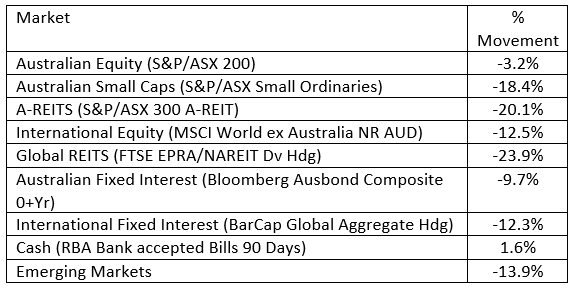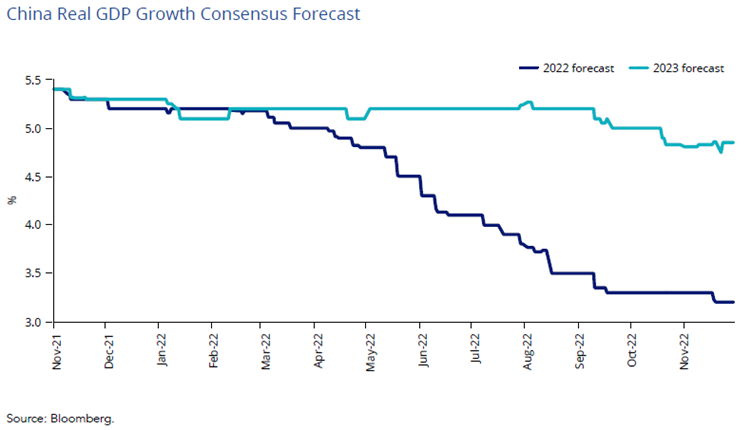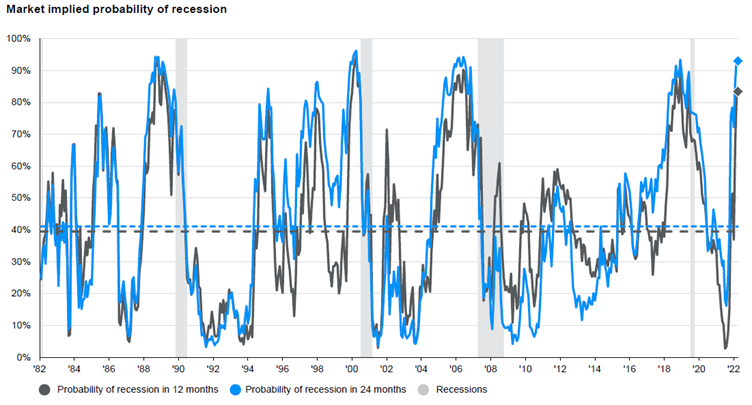Navigating markets in 2023 will require patience, diligence and an active overlay as volatility is likely to reign supreme.
“Successful investing is anticipating the anticipations of others” – John Maynard Keynes.
With eight interest rate increases in 2022, taking our official cash rate from 0.1% (April 2022) to 3.10% (December 2022) it would be fair to say that 2022 was the ‘Year of Intervention’. Globally, the pace of rate increases averaged 4%. The quote from Keynes above was very apt last year, as investors had to anticipate what moves central banks would make in response to high and rising inflation.
In fact, 2022 was so hard on investors it was only the third time (1931, 1969 and 2022) in the last 100 years that both equities and bonds recorded negative returns together. With so many external forces at play it was little wonder that we started to see a weakening consumer, all of which led to a “risk off” environment.
The following table highlights just how large some of the market falls were.

Looking ahead
Will the dark stormy clouds that shaped so much of 2022 finally clear and leave us with a visible path ahead? Unfortunately, the forecast is for continued storm clouds and rough seas, so let’s turn our attention to some of the most important factors that are likely to shape 2023.
Ukraine War
Russia’s conflict with Ukraine is having a devasting impact on the Ukrainian people, causing a humanitarian, social and economic crisis. The military invasion has disrupted the global supply chains resulting in skyrocketing food and energy prices and undermining the progress made in recovering from the COVID-19 pandemic. Countries that have strong trade and financial connections with Russia and Ukraine are particularly at risk.
Unfortunately, most military analysts see little chance of a resolution inside the next 12 months, with Russia massing its troops in Belarus biding their time for another push on Kiev. This, together with the amount of western firepower being sent to Ukraine, means there is little chance of a political cease fire. It will take a decisive military outcome or the removal of President Putin.
The war will continue the economic drag being felt in Europe and countries such as Germany, who has relied heavily on Russian gas, will feel the brunt of it. As Germany is Europe’s economic powerhouse, we continue to believe that Europe is likely to enter a recession in 2023.
While other European countries such as Spain, Portugal, Italy and Greece are less reliant upon Russia’s oil and gas, they are still likely to be dragged into recession thanks to higher interest costs on their ballooning debt as the ECB looks to fight its own inflationary problems.
China
China’s draconian COVID-Zero response not only locked down the civilian population but also shuttered the economy. It has been estimated that China’s economic lockdown reduced oil demand by 1 million barrels per day.
Prior to COVID, China was transitioning its economy from export orientated production to internal domestic consumption, not unlike most developed nations. During 2022, its domestic consumption took a massive hit and towards the end of 2022, we witnessed mass civil unrest in numerous cities, something that the leadership will not tolerate and fears the most.
Following this unrest, the COVID-Zero policy has been jettisoned, just in time for the traditional week long Lunar New Year celebrations. Given this holiday sees one of the biggest migrations of people in the world it will be interesting to see how the infection rate of COVID develops.
China will be looking to kick start its economy once again and the central government has already made key announcements to support the property markets, banks and manufacturers. Any economic bounce will be modest compared with those that followed the global financial crisis in 2009 and the 2020 Wuhan lockdown, given the expected global recession, uncertainty around the exit path from COVID-19, and the lack of willingness and capacity to overstimulate the economy.

Inflation
Inflation continued to trend higher in 2022 across most economies as supply chains had yet to fully recover from pandemic-related distortions and as demand was buoyed by strong household and business balance sheets. Inflation has likely already peaked in most markets, but reducing price pressures tied to labor markets and wage growth will take longer.
The key questions driving markets in 2023 will be how high will interest rates go? And, will the rate increases push economies into recession?
On the interest rate front, we expect the US Federal Reserve to take the cash rate to 5.25% in 2023 – another three 0.25% increases. In Australia, we expect a similar number of increases to take our cash rate to 3.85%. Once these levels are achieved, we expect both central banks to sit on the sidelines for the rest of the year as they wait and see what impact it has upon the economy.
While estimating how high interest rates will go is not easy, it is far harder to accurately predict whether a country will enter a recession. That being said, we think Europe will do so for the reasons already discussed and we think the US will also enter a mild recession.
The following chart from J.P Morgan compiles numerous US economic indicators into a single probability predictor of future recessions. Looking back over the last 40 years, each time the indicator has reached the current levels, the US has entered a recession within the next 24 months.

We noted above that headline US inflation appears to have peaked and that is primarily due to the easing of conditions on the supply side. However, we expect inflation to remain sticky and elevated due to the challenges the services industry faces. In the US, the bulk of the economy is consumption based and traditionally that has been services orientated as manufacturing decreased significantly over the past 50 years.
How do you get inflation to decline? You need to get wages to fall back to a growth rate consistent with your inflation target (2% to 3% for the US Federal Reserve). Enter the Non-Accelerating Inflation Rate of Unemployment (NAIRU). NAIRU is the unemployment rate at which wages have no tendency to either pick up pace or fall away.
US employers bid up wages to fill job vacancies. Normally the relationship between vacancies and the unemployment rate is pretty stable. But with economic dislocation and older cohorts leaving the labour market, there is currently a higher rate of vacancies for a given level of unemployment.
This suggests the unemployment rate required to stabilise wages growth is higher than before. So, to get wages growth rate down requires an unemployment rate higher than this.
The US Federal Reserve is hoping for a “soft landing” which essentially means they hope to find a balance between raising rates sufficiently to bring inflation down and yet not push the economy into recession. As Goldilocks found, it is very difficult to get that temperature just right.
Earnings Forecasts / Markets
For the last 10 years, the US Federal Reserve has effectively told markets not to worry as they have their back. If markets fell dramatically or economic conditions deteriorated, they simply cut interest rates or pumped liquidity into the system.
While that worked historically and was the correct course of events some of the time, that playbook is no longer available. Inflation is the kryptonite of any central banker, they all know their history and understand how devasting it can be if it becomes entrenched.
The problem is that market traders are showing classic signs of behavioral bias, ‘anchoring’ specifically. They have seen how central banks behaved over the past decade and they firmly expect them to do that again. That is why markets are rallying on bad news as bad news means that interest rates won’t keep rising and in fact will start falling.
At the moment, most market participants expect central banks will be forced to cut rates in late 2023 as their economies fall into recession. The dilemma for central banks though is – will they reduce rates if inflation remains sticky and the unemployment rate remains near record lows? I suspect not.
In order for there to be rate cuts, we need to see dramatic falls in inflation and increases in unemployment and that means the economy is very unhealthy. Hardly a time when corporate earnings are rising, which should mean that share prices are falling.
Equity markets have yet to drop materially below their fair-value range, which they have historically done during recessions. In November the US curve, that is the 10 and 2-year yields, inverted further. An inverted curve is a widely regarded indicator for a recession. Not that equity markets reflect this.
We have seen the most deeply inverted US yield curve since the Paul Volker era of the early 1980s and US Federal Reserve officials expect to keep rates higher through this year, with no reductions until 2024, though signs are emerging that growth is buckling.
If the US is heading into recession, as we believe, earnings expectations are still way overcooked. While earnings per share (EPS) expectations for 2023 have declined modestly from +9.6% in June 2022 to +4.8% at the end of the year, they are still positive i.e., analysts expect companies to make more money during a recession! A recession normally sees EPS fall 20% to 40%. For reference, 2008 saw EPS fall circa 90%.
How is that manageable? Analysts simply expect the US Federal Reserve to savagely cut rates late in the year, providing another liquidity boom to companies.
If corporate earnings do fall, as we suspect, it’s also likely market valuations have not fallen far enough to justify the earnings risk. Price to earnings (P/E) ratios usually bottom out anywhere from 9x to 14x following a recession, well below current levels. The other thing that will be priced lower once the US recession is fully considered is the US dollar.
If China’s economy can pick back up and Australia avoids a property implosion, the Australian dollar may do very well, especially against a sliding US dollar contending with a recession. An easing of Chinese trade restrictions, on the back of a new government here, will be the icing on the cake.
The playbook for 2023 is to avoid highly volatile and speculative investments and maintain ample liquidity, as opportunities will become evident.
Andrew Aylward is Chief Investment Officer at Keep Wealth Partners.
For more information contact us on 03 8610 6396
Keep Wealth Partners Pty Ltd (AFSL 494858)
This information is of a general nature only and may not be relevant to your particular circumstances. The circumstances of each investor are different, and you should seek advice from a financial planner who can consider if the strategies and products are right for you.







